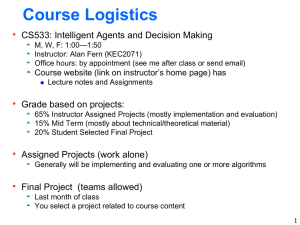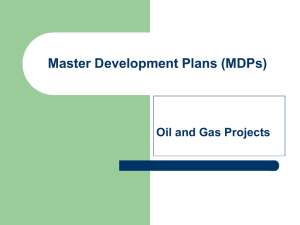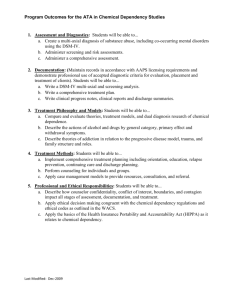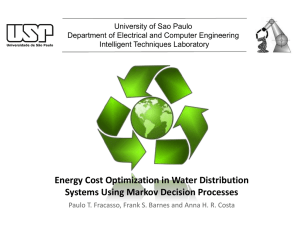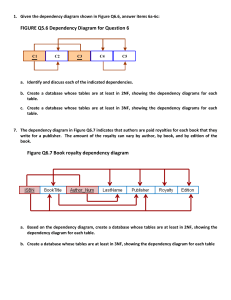Decentralized Markov Decision Processes with Event
advertisement
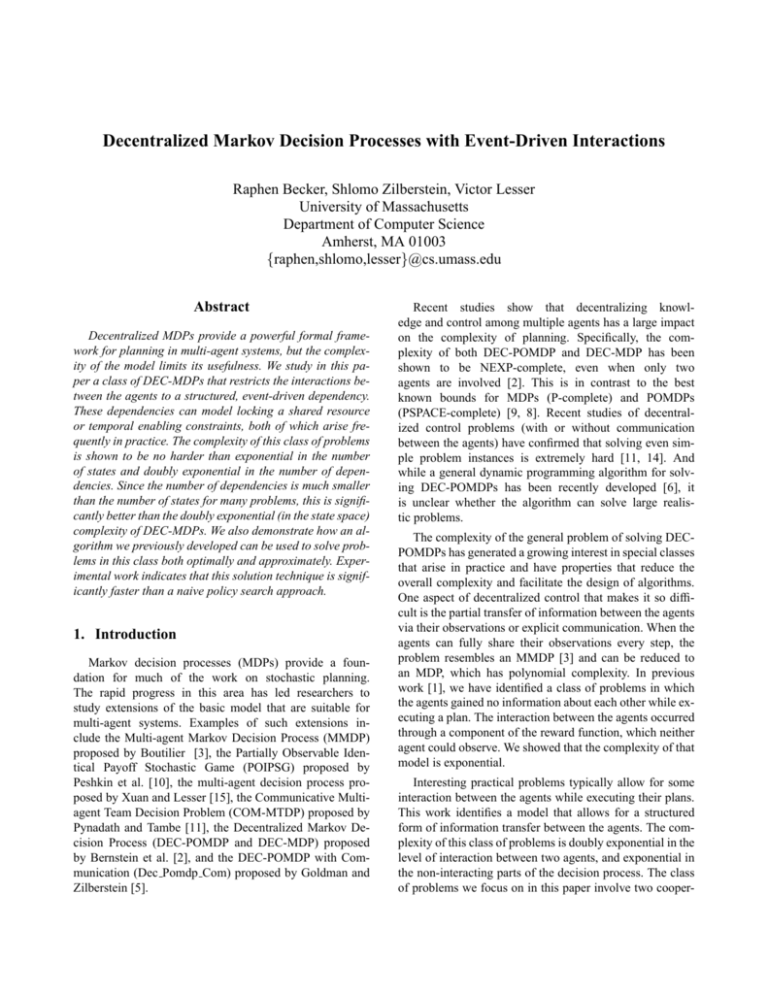
Decentralized Markov Decision Processes with Event-Driven Interactions
Raphen Becker, Shlomo Zilberstein, Victor Lesser
University of Massachusetts
Department of Computer Science
Amherst, MA 01003
{raphen,shlomo,lesser}@cs.umass.edu
Abstract
Decentralized MDPs provide a powerful formal framework for planning in multi-agent systems, but the complexity of the model limits its usefulness. We study in this paper a class of DEC-MDPs that restricts the interactions between the agents to a structured, event-driven dependency.
These dependencies can model locking a shared resource
or temporal enabling constraints, both of which arise frequently in practice. The complexity of this class of problems
is shown to be no harder than exponential in the number
of states and doubly exponential in the number of dependencies. Since the number of dependencies is much smaller
than the number of states for many problems, this is significantly better than the doubly exponential (in the state space)
complexity of DEC-MDPs. We also demonstrate how an algorithm we previously developed can be used to solve problems in this class both optimally and approximately. Experimental work indicates that this solution technique is significantly faster than a naive policy search approach.
1. Introduction
Markov decision processes (MDPs) provide a foundation for much of the work on stochastic planning.
The rapid progress in this area has led researchers to
study extensions of the basic model that are suitable for
multi-agent systems. Examples of such extensions include the Multi-agent Markov Decision Process (MMDP)
proposed by Boutilier [3], the Partially Observable Identical Payoff Stochastic Game (POIPSG) proposed by
Peshkin et al. [10], the multi-agent decision process proposed by Xuan and Lesser [15], the Communicative Multiagent Team Decision Problem (COM-MTDP) proposed by
Pynadath and Tambe [11], the Decentralized Markov Decision Process (DEC-POMDP and DEC-MDP) proposed
by Bernstein et al. [2], and the DEC-POMDP with Communication (Dec Pomdp Com) proposed by Goldman and
Zilberstein [5].
Recent studies show that decentralizing knowledge and control among multiple agents has a large impact
on the complexity of planning. Specifically, the complexity of both DEC-POMDP and DEC-MDP has been
shown to be NEXP-complete, even when only two
agents are involved [2]. This is in contrast to the best
known bounds for MDPs (P-complete) and POMDPs
(PSPACE-complete) [9, 8]. Recent studies of decentralized control problems (with or without communication
between the agents) have confirmed that solving even simple problem instances is extremely hard [11, 14]. And
while a general dynamic programming algorithm for solving DEC-POMDPs has been recently developed [6], it
is unclear whether the algorithm can solve large realistic problems.
The complexity of the general problem of solving DECPOMDPs has generated a growing interest in special classes
that arise in practice and have properties that reduce the
overall complexity and facilitate the design of algorithms.
One aspect of decentralized control that makes it so difficult is the partial transfer of information between the agents
via their observations or explicit communication. When the
agents can fully share their observations every step, the
problem resembles an MMDP [3] and can be reduced to
an MDP, which has polynomial complexity. In previous
work [1], we have identified a class of problems in which
the agents gained no information about each other while executing a plan. The interaction between the agents occurred
through a component of the reward function, which neither
agent could observe. We showed that the complexity of that
model is exponential.
Interesting practical problems typically allow for some
interaction between the agents while executing their plans.
This work identifies a model that allows for a structured
form of information transfer between the agents. The complexity of this class of problems is doubly exponential in the
level of interaction between two agents, and exponential in
the non-interacting parts of the decision process. The class
of problems we focus on in this paper involve two cooper-
ating agents, each having its own local set of tasks to perform, with a specific structured interaction between them.
This interaction allows the outcome of actions performed
by one agent to depend on the completion of certain tasks
by the other agent. This form of interaction has been studied extensively within the multi-agent community [7, 12].
Some instances of this type of interaction that have been
previously studied are enables/facilitates interrelationships,
whereby one agent executing a task enables the other agent
to execute another task, or it may increase the likelihood
of success. Another example is a non-consumable resource,
which one agent can lock and thus prevent the other agent
from using.
In addition to the naive approach (complete policy search) to solving a problem like this, we introduce
a mapping that allows the optimal policy to be found using our previously developed Coverage Set Algorithm [1].
The key idea is that given a policy for one agent we can construct an MDP to find the corresponding optimal policy
for the other agent. This new augmented MDP is constructed based on a set of parameters computed from the
fixed policy. The Coverage Set Algorithm takes this augmented MDP and finds the set of optimal policies for
all possible parameter values. This set includes the optimal joint policy. Our experimental results show that this
solution technique performs much better than the naive algorithm.
Section 2 provides a formal description of the problem,
illustrated with an example in the TAEMS task description
language. In section 3, we identify an upper-bound on the
complexity of this class of problems by examining the running time of the complete policy search. Complete policy
search is not a good way to solve problems of this type,
however, and in section 4 we discuss an alternative algorithm. Section 5 demonstrates the performance of this algorithm on a problem modelled in TAEMS. The contributions
of this work and directions for further work are summarized
in section 6.
2. Formal Definition of the Model
Intuitively, the special class of problems we focus on involves two agents, each having a “local” decision problem
or task that can be modeled as a standard MDP. This local decision problem is fully observable by the agent. The
agents interact with each other via a set of structured transition dependencies. That is, some actions taken by one agent
may affect the transition function of the other agent.
To illustrate this concretely, we present a problem in
TAEMS [4]. TAEMS is a hierarchical task modeling language that has been used successfully in a number of real
systems [13]. Figure 1 is an example task structure. In it,
the two agents each have one task: T1 for agent 1 and T2 for
agent 2. Both of those tasks can be decomposed into two
Agent 1
Agent 2
T1
T2
max
max
e
T11
sum
M11
M12
M13
T12
T21
sum
sum
M14
M21
e
T22
sum
M22
M23
M24
enables
facilitates
Figure 1. An example TAEMS task structure
subtasks, i.e. T1 → T11 and T12 . Each of the subtasks is decomposed into two methods, i.e. T11 → M11 and M12 . Methods are the atomic units of a task and the agents can execute them. Executing a method takes time and produces
quality, over some distribution. A quality of 0 represents a
method that has not been successfully executed. Tasks accumulate quality from their children in many different ways.
Two are shown in the example: sum and max. The quality
of T11 is the sum of the qualities of its children, and the quality of T1 is the max quality of its children. The goal of the
system is to maximize the sum of the qualities of the highest level tasks in both agents before the deadline.
The two agents do not operate independently, however.
TAEMS has three different types of interrelationships between agents, only one of which is used in this example:
facilitates/enables. This type of interrelation is a temporal
constraint: M14 must be executed successfully before M24
is executed for M24 to produce a nonzero quality. Facilitates
is similar though less severe. If M23 is successfully executed
before M12 , then M12 is more likely to produce a higher quality than if it was not facilitated. These are examples of the
type of dependencies allowed between agents in our model,
though it is not limited to interrelations of this nature.
To define these kind of dependencies more formally, we
need to first introduce the general model of decentralized
MDPs [2].
Definition 1 A 2-agent DEC-MDP is defined by a tuple
hS, A, P, R, Ω, Oi, where
• S is a finite set of world states, with a distinguished initial state s0 .
• A = A1 × A2 is a finite set of actions. Ai indicates the
set of actions taken by agent i.
• P is a transition function. P (s0 |s, a1 , a2 ) is the probability of the outcome state s0 when the action pair
a1 , a2 is taken in state s.
• R is a reward function. R(s, a1 , a2 , s0 ) is the reward
obtained from taking actions a1 , a2 in state s and transitioning to state s0 .
• Ω is the set of all observations for each of the agents.
• O is the observation function. O(s, a1 , a2 , s0 , o1 , o2 ) is
the probability of agents 1 and 2 seeing observations
o1 , o2 respectively after the sequence s, a1 , a2 , s0 occurs.
• Joint full observability: the pair of observations made
by the agents together fully determine the current state.
If O(s, a1 , a2 , s0 , o1 , o2 ) > 0 then P (s0 |o1 , o2 ) = 1.
Definition 2 A factored, 2-agent DEC-MDP is a DECMDP such that the world state can be factored into two
components, S = S1 × S2 .
Factoring the state space of a DEC-MDP could be done
in many ways. The intention of such a factorization is a separation of components of the world state that belong to one
agent versus the other. This separation does not have to be
strict, meaning that some components of the world state
may not belong to either agent and could be included in
both. For example, time could be a component of S1 and
S2 .
We refer to si , ai and oi –the components of the factored DEC-MDP that apply to just one agent–as the local
states, actions, and observations for agent i. Just as in a
DEC-MDP, a local policy (or just policy) for one agent is
a mapping from sequences of observations to local actions
(we will simplify this later). A joint policy is a set of policies, one for each agent.
Our TAEMS example can be represented by a factored
DEC-MDP:
• The local state of each of the agents is composed of the
current time and the qualities of each of the methods.
• The actions for the agents are to execute one of their
methods.
• The transition function is based on the time/quality
distribution for the methods the agents choose to execute, taking into account the facilitates/enables interrelationships.
• The reward is only received in a terminal state, and it
represents the sum of the qualities of the highest level
tasks at that time.
• Each agent fully observes is own local state. In addition, when an agent attempts to execute a constrained
method it learns whether the interrelationship was satisfied.
What is interesting about factoring a DEC-MDP is not
that the world state can be factored but the properties that a
particular factorization have. In this problem we are looking
for a factorization that minimizes the interaction between
the two agents. The next two definitions introduce some interesting properties that the factored, 2-agent DEC-MDPs
we are working with have.
Definition 3 A factored, 2-agent DEC-MDP is said to be
locally fully observable if ∀oi ∃si : P (si |oi ) = 1.
That is, each agent fully observes its own local state at
each step. Note that Ω and O are now redundant in the definition of a factored 2-agent DEC-MDP with local full observability and can be removed.
Definition 4 A factored, 2-agent DEC-MDP is said to be
reward independent if there exist R1 and R2 such that
R((s1,s2 ),(a1,a2 ),(s01,s02 )) = R1 (s1,a1,s01 )+R2 (s2,a2,s02 )
That is, the overall reward is composed of the sum of
the local reward functions, each of which depends only on
the local state and action of one of the agents. In the example, the reward is received only in the terminal states and it
is additive between tasks and across agents, therefore the reward function for this factorization is reward independent.
Next we define the interaction between the two agents as
event-driven, meaning that an event in one agent influences
an event in the other agent.
2.1. Event-Driven Interactions
In this section we will fully define the transition function. The basic idea is that transitions can take two forms.
First, many local transitions for one agent are independent
of the other agent, which means that they depend only on
the local state and action. However, the interrelationships
between the agents mean that some transitions depend on
the other agent. This interaction is described by a dependency and the change in transitions that result when the dependency is satisfied. We start by defining events, which
form the basis of the dependency.
Definition 5 A primitive event, e = (si , ai , s0i ) is a triplet
that includes a state, an action, and an outcome state. An
event E = {e1 , e2 , ..., eh } is a set of primitive events.
The history for agent i, Φi = [s0i , a0i , s1i , a1i , ...] is a valid
execution sequence that records all of the local states and
actions for one agent, beginning with the local starting state
for that agent. A primitive event e = (si , ai , s0i ) occurs in
history Φi , denoted Φi |= e, iff the triplet (si , ai , s0i ) appears
as a subsequence of Φi . An event E = {e1 , e2 , ..., eh } occurs in history Φi , denoted Φi |= E iff ∃e ∈ E : Φi |= e.
Events are used to capture the fact that an agent did some
specific activity like execute a method that enables a remote
task. In some cases a single local state may be sufficient,
but because of the uncertainty in the domain that method
could be executed from many different states (different current times, different current qualities for the other methods)
we generally need a set of primitive events to capture an activity.
An example of an event would be successfully executing M14 before time 10. It would be composed of primitive
events of the form (time < 10, q11 , q12 , q13 , q14 = 0), execute
M14 , (time < 10, q11 , q12 , q13 , q14 > 0), where qik is the current quality of method Mik .
Definition 6 A primitive event is said to be proper if it can
occur at most once in any possible history of a given MDP.
That is ∀Φ = Φ1 eΦ2 : ¬(Φ1 |= e) ∧ ¬(Φ2 |= e). An
event E = {e1 , e2 , ..., eh } is said to be proper if it consists of mutually exclusive proper primitive events with respect to some given MDP. That is:
∀Φ ¬∃i 6= j : (ei ∈ E ∧ ej ∈ E ∧ Φ |= ei ∧ Φ |= ej )
We limit the discussion in this paper to proper events because they are sufficient to express the desired behavior and
because they simplify discussion. For a discussion on how
non-proper events can be made proper see [1].
The event executing M14 before time 10 is proper because
the primitive events that compose the event include the transition from q14 = 0 to q14 > 0. Since the quality of a task is
always nondecreasing, this transition can never occur twice.
The interaction between the agents takes the form of a
triggering event in agent i and a set of state-action pairs for
agent j that is affected. This interaction is called a dependency.
Definition 7 A dependency dkij = hEik , Djk i, where Eik is
a proper event defined over primitive events for agent i, and
Djk is a set of unique state-action pairs for agent j. Unique
0
means ¬∃k, k 0 , sj , aj s.t. hsj , aj i ∈ Djk ∧ hsj , aj i ∈ Djk ∧
k 6= k 0 .
Definition 8 A dependency dkij is satisfied when Φi |= Eik .
Boolean variable bsj aj is true if the related dependency is
satisfied and false if it is not satisfied or there is not a related dependency:
true ∃k, s.t. hsj , aj i ∈ Djk ∧ Φi |= Eik
bsj aj =
false otherwise
Definition 9 A transition function for event driven interactions is divided into two functions, Pi and Pj . They define
the distribution Pi (s0i |si , ai , bsi ai ).
When an agent takes an action that could be influenced
by a dependency it learns the status of that dependency,
whether or not it was satisfied (i.e. whether the task was facilitated). The idea is that an agent knows why things happened after they do. For example, if an agent attempts to execute a task that has not been enabled, it realizes that it does
not have the data necessary for the task when it fails. An argument can be made that the agent should be able to check
whether it has the available data before it attempts to execute the task. This can be accomplished by a ‘free’ action
that reveals the status of the dependency. Essentially, the dependency modifies the transition for the free action in addition to facilitating the task.
Dependency d10
1,2 is the dependency that represents
method M24 having been enabled when agent 2 attempts to execute it at time 10. The event E110 is the event
described earlier where the enabling method M14 has finished executing successfully before time 10. D210 contains
state-action pairs representing agent 2 attempting to execute M24 at time 10. There is exactly one dependency of
this type for each time that agent 2 could attempt to execute
method M24 . If agent 1 successfully executes M14 at time 6,
then all of the dependencies dt1,2 where t > 6 will be satisfied (by the same primitive event in agent 1), but each of
those satisfied dependencies modify a different set of probabilities in agent 2. Agent 2 can attempt M24 at time 10 and
again at time 14, and both times the method will be en14
abled but through different dependencies (d10
1,2 and d1,2
respectively).
2.2. Defining the Policy
While we have defined a local state space, action space,
transition function and reward function for each agent, this
unfortunately does not define a local MDP for each agent.
The reason is because the local state is not Markov. When
an agent learns the status of a dependency, it changes its belief about the state of the other agent and the impact of future dependencies. This information is contained within the
history of an agent, but not in the previously defined local
state. Therefore, the local state Si of agent i must be modified to include the dependency history (i.e. at time t dependency dkij was satisfied). This modified local state is Si0 .
hSi0 , Ai , Pi , Ri i does define a local MDP, and the local policy for agent i is πi : Si0 → Ai .
When one of the TAEMS agents attempts a task with an
incoming dependency, its next observation includes whether
that dependency was satisfied (i.e. was that task enabled).
That information is not stored in the local state of the agent
that we defined earlier because it was not necessary in
the DEC-MDP (transitions in the DEC-MDP are defined
over world states not local states). However, that knowledge changes this agent’s belief about the other agent’s local state, and that could influence a future expectation of a
method being enabled.
In the general case the state will need to include a variable for each dependency, which encodes all of the information gained about that dependency. For specific problems,
however, that information is often redundant. For example,
in TAEMS the state needs to include the time the outgoing
interrelations are enabled, the last time an incoming interrelation was not enabled and the first time it was enabled.
This information completely encodes everything an agent
knows about the dependencies. It is important to notice that
in the TAEMS case information is recorded per interrelationship, not per dependency. This is because each interrelationship has multiple dependencies associated with it.
2.3. Evaluating a Joint Policy
The value function that we are trying to maximize is the
original value function for the DEC-MDP. However, evaluating a pair of policies is much easier on a new DEC-MDP
constructed from the expanded local states and new transition function because the policies are not defined over the
same state space as the original DEC-MDP.
•
•
•
•
•
The states S 0 = S10 × S20 .
The actions A = A1 × A2 .
The transition function P = P1 × P2 .
The reward function R = R1 + R2 .
The observations for each agent are its local component of the state.
The expected reward the system will receive given a pair
of policies can be found by running policy evaluation as if
this was an MDP because there is a direct mapping from
world state to joint action.
3. Problem Complexity
An upper bound on the complexity of the DEC-MDP
with event driven interactions can be derived from the complexity of complete policy search.
Theorem 1 A DEC-MDP with event driven interactions
has complexity exponential in |S| and doubly exponential
in the number of dependencies.
Proof In a DEC-MDP with event driven interactions, the
number of joint policies is exponential in the number of
states because the policy is a mapping from states to actions (unlike the DEC-MDP which is a mapping from sequences of observations to actions). However, the number
of states in the new DEC-MDP is exponentially larger in
the number of dependencies than the original state space.
Therefore, the number of joint policies is exponential in the
original state space and doubly exponential in the number
of dependencies.
Evaluating a policy can be done with standard policy
evaluation for MDPs because in the new DEC-MDP, the
joint policy is a direct mapping from world states to joint
actions. Policy evaluation for MDPs is polynomial in the
number of states, so this does not raise the complexity.
Therefore, the DEC-MDP with event driven interactions
has complexity exponential in |S| and doubly exponential
in the number of dependencies.
The reason this class of problems is easier to solve than
DEC-MDPs is because the size of the policy space has been
reduced. It was reduced by separating the part of the history
that is necessary to be memorized (interactions between the
agents) from the part that is not necessary (local state). Specific problems may have additional structure that further reduces the complexity. For example, in TAEMS the complete interaction history is not necessary to remember so
the complexity is doubly exponential in the number of facilitates/enables, not the number of dependencies. If the problem is such that there is an ordering over the interactions and
only the most recent interaction must be memorized then the
complexity drops to exponential.
4. Solving the Problem
Solving an exponential (or worse) problem using complete policy search is intractable for all problems of moderate or larger size. The reason is that for complete policy
search, the worst case complexity is also the best case complexity. That means for every problem every policy must
be evaluated, regardless whether it has characteristics that
make it a simple problem. Some problems, however, are
structured such that many policies are clearly worse than
other policies. For example, suppose M14 and M24 have
quality outcomes significantly higher than the other methods. A simple analysis of the problem would indicate that
nearly any policy that attempts both M14 and M24 has a
higher value than any policy that does not. This significantly
reduces the number of policies that must be searched.
While the worst case complexity of the Coverage Set Algorithm may be similar to complete policy search, the best
case is only polynomial in the state space and exponential
in the number of dependencies. The reason the Coverage
Set Algorithm has such a variance in complexity is that it
is essentially performing a general analysis of the problem.
The more obvious a solution, the faster the algorithm runs.
However, in the worst case, no useful information is gained
through the analysis and it will perform slower than complete policy search due to extra overhead.
4.1. Coverage Set Algorithm (CSA)
The algorithm can be divided into three steps: create
the augmented MDP, find the optimal coverage set, search
through the set for the optimal joint policy. Each of the three
steps is summarized below. For a detailed explanation of the
CSA including pseudo-code, see [1].
4.1.1. Augmented MDP The first step is a domain specific step involving translating the problem into a form the
CSA works with. This is done by creating an augmented
MDP. An augmented MDP is a decision problem for agent
i that maximizes the global value given a fixed policy for
agent j. This may not be the optimal joint policy, but it is
π2
π2
π2
π
0
0.5
x
(a)
1
π1
0
0.4
0.6
1
π3
Value
π
1
Value
Value
3
π1
0
1
x
x
(b)
(c)
Figure 2. Illustration of the search process in
a one dimensional parameter space.
tersections between those three lines yield two new points,
0.4 and 0.6. Since no new optimal policies are discovered
at those two points, the search is finished and the three optimal policies found form the optimal coverage set.
4.1.3. Optimal Joint Policy The final step in the algorithm is to find an optimal joint policy. One of the policies in
the optimal coverage set is part of an optimal joint policy.
To find it, the algorithm performs a policy search through
the relatively small set. For each policy in the set it finds the
corresponding optimal policy for agent j and evaluates the
joint policy. The best pair is the optimal joint policy.
4.2. Constructing the Augmented MDP
the absolute best policy agent i could choose given the fixed
policy for agent j.
An augmented MDP has three properties. First, an augmented MDP is an MDP defined over the states and actions
for agent i given a policy πj for agent j. The transition function and reward function can depend on πj .
Second, the augmented MDP maximizes the global value
of the system for a given policy for agent j. This means that
the policy for agent j can be evaluated independently of the
policy agent i adopts, and the global value is equal to the
independent expected value of agent j’s policy plus the expected value of the augmented MDP given both policies:
π
GV (πi , πj ) = Vπj (s0j ) + Vπij (s0i ).
The third and final property of the augmented MDP is
π
that the value function of the augmented MDP, Vπij (s0i ),
must be a linear combination of a set of parameters computed from the policy for agent j. Note that any nonlinear
function can be made linear by adding additional parameters.
If an augmented MDP can be created for a problem, then
the CSA can find the optimal joint policy for that problem.
4.1.2. Optimal Coverage Set The second step of the algorithm corresponds to the analysis of the problem. Each
policy for agent j is reducible to a set of parameters with
agent i. Each augmented MDP has an optimal policy. That
set of optimal policies is the optimal coverage set for agent
i. An ‘easy’ problem is one in which agent i has the same
optimal policy for many different agent j policies, and the
size of its optimal coverage set is small.
The optimal coverage set can be viewed geometrically as
a piecewise-linear and convex surface over the parameters
taken from agent j’s policies. The pieces of the surface are
composed of the value functions of the augmented MDPs
with their corresponding optimal policies. They are found
through a search process, illustrated in Figure 2.
First, optimal policies at the boundaries of the parameter space are found using dynamic programming on the augmented MDPs instantiated by x = 0, (π 1 ), and x = 1, (π 2 ),
Figure 2(a). Next, those lines are intersected and a new optimal policy π 3 is found for x = 0.5, Figure 2(b). The in-
To show that the CSA can be used for this problem, we
must define an augmented MDP.
Let M DPi = hSi0 , Ai , Pi , Ri i represent the loπ
cal MDP for agent i as defined earlier. Let M DPi j =
hSi0 , Ai , Pi0 , Ri0 i represent the augmented MDP for a given
πj . The states and actions do not change in the augmented MDP, but the transition function and reward function do. The transition function changes to take into account
the incoming dependencies, dkji . It is modified by the likelihood that an incoming dependency is satisfied in the other
agent and the change in probability that dependency incurs.
Definition 10 Pi0 (s0i |si , ai ) is the transition function for the
augmented MDP. For the probabilities not altered by an incoming dependency, Pi0 (s0i |si , ai ) = Pi (s0i |si , ai , f alse).
For the others,
∀k, hsi , ai i ∈ Dik , Pi0 (s0i |si , ai ) = Pi (s0i |si , ai , f alse)+
P (dkji |si ) [Pi (s0i |si , ai , true) − Pi (s0i |si , ai , f alse)] ,
where P (dkji |si ) is the probability that dependency dkji is
satisfied given that agent i is in state si .
The reward function is modified to incorporate the
changes in expected value the other agent receives when
outgoing dependencies are satisfied.
Definition 11 Ri0 (si , ai , s0i ) is the reward function for
the augmented MDP. For each primitive event e =
hsi , ai , s0i i that does not satisfy an outgoing dependency, Ri0 (si , ai , s0i ) = Ri (si , ai , s0i ). For the others,
∀k, hsi , ai , s0i i ∈ Eik , Ri0 (si , ai , s0i ) =
s0
Ri (si , ai , s0i ) + Vπji (s0j ) − Vπsji (s0j ),
where Vπsji (s0j ) is the expected value of the start state of
agent j’s local MDP given the policy πj and the dependency history contained in si .
The parameters from agent j’s policy and MDP take two
forms, P (dkji |si ) and Vπsji (s0j ). Neither of these is difficult
Agent 1
Agent 2
T1
T2
max
max
e
sum
M11
e
T21
T12
T22
M13
M21
*
M23
t = 5, q1 = 1, q2 = 1
M2
enables
Figure 3. The TAEMS problem structure for
the experiments.
0
Agent 1
Agent 2
1
M1
M2 q =1
*
M3
t = 5, K
t = 5, K
*
*
∅
t = 4, q2 = 2
M2
M22
t = 2, q1 ≥ 1
*
t = 3, 4,5, q2 = 1;
*
q1 = 1, q2 = 2;
M1
M2
M3
M1
sum
M12
t = 3, q1 = 0, q2 = 2
q2 = 0
*
M1
T11
t = 2, q1 = 0;
Agent 2
Agent 1
M1
*
2
3
M3
q =1
M1 q =1
4
q =2 enable
M3 q =0
fail
5
Reward
2
M3 q = 4
4
Global Value:
6
M2
6
q =1
Figure 4. The optimal joint policy and an example execution.
to compute, and they can be derived at the same time. The
value V can be obtained by running policy evaluation on
the MDP obtained by applying the dependencies satisfied
in si . At the same time, the probability of reaching each
state can be computed. P (dkji |si ) is the sum of the probabilities of all primitive events in Ejk that have a consistent
dependency history with si .
A value function for an MDP can be represented as
the sum over all primitive events in the MDP, the probability of that primitive event occurring times the reward received at that primitive event. This function can
be converted to the form V = c0 + c1 x1 + c2 x2 + ...
where xn is the product of one or more parameters (i.e.
P (d3ji |s6 )P (d5ji |s13 )P (d5ji |s16 )). Partially symbolic policy evaluation would generate a value function with this
form. While this function is not linear in the parameters, it is linear in these combinations of parameters.
Having a linear value function allows the use of the Coverage Set Algorithm.
5. Experimental Results
To test the algorithm on this class of problems, we implemented the example problem shown in Figure 3, which
is a simple variant of Figure 1. This section will examine a typical instance of this problem in detail. The agents
had 6 time steps to execute their methods. Each method
took between 1 and 3 time steps to complete. Methods
M 1 and M 2 produced an integer quality between 0 and
2, while M 3 produced a quality of 0, 2 or 4. The method
M23 took 1 time step and produced quality 0 if not enabled. After executing M23 agent 2 knows whether it was
enabled or not. The agents received a reward after the time
ran out equal to the final quality of their task. The global
reward being maximized is the sum of the local rewards:
M ax(q11 + q12 , q13 ) + M ax(q21 + q22 , q23 ).
There are four dependencies that represent M23 being
enabled at times 2 through 5 (2 is the first time it could
be enabled and 6 is the deadline). The state of each agent
also includes information about these dependencies. Agent
1 keeps track of the last dependency that was satisfied (for
a total of 945 states). Agent 2 keeps track of the last dependency that was not satisfied and the first dependency that
was (for a total of 4725 states).
The dimensionality of the search was also different for
the two agents because they are on different sides of the dependencies. Agent 1, being the enabler, had parameters that
represented the expected value for agent 2 given that agent 1
enabled at time t. There were four different times that agent
1 could enable agent 2 and another parameter for when
agent 2 was never enabled leading to a parameter space of
size five. Agent 2, being on the receiving end, depends on
the probability that it was enabled given the current time
and the last time it learned it was not enabled. There were
ten probabilities, but the parameter space depended on combinations of those probabilities and was much higher. Since
agent 1 had a much lower dimensionality, we chose to find
its optimal coverage set.
Figure 4 shows an FSM representation of the optimal
joint policy for one instance of the problem. The vertices
are the actions taken and the edges are transitions based on
the current state. The * matches any state not matched by
a more specific label. The optimal coverage set for agent 1
contained 141 policies and took less than an hour to find on
a modern desktop computer.
While the complexity of these decentralized MDPs with
event-driven interactions is significantly easier than models
like the DEC-MDP, it is still intractable for large problems
and certain hard small problems. Fortunately, it turns out
that the coverage set algorithm is naturally an anytime algorithm with some very nice characteristics. Finding an optimal or near optimal solution usually takes very little time.
Proving that the solution is optimal takes the majority of the
computation. For example, the expected value of the optimal joint policy in Figure 4 is 5.8289. The first joint policy
found had a value of 5.6062, or 96.2% of optimal. The optimal joint policy was discovered after only 0.004% of the
total computation. The result is a good anytime solution for
problems too large to solve optimally.
6. Conclusion
The DEC-MDP framework has been proposed to model
cooperative multi-agent systems in which agents receive
only partial information about the world. Computing the optimal solution to the general class is NEXP-complete, and
with the exception of [6] the only known algorithm is brute
force policy search. We have identified an interesting subset of problems that allows for interaction between the two
agents in a fixed, structured way. For this class of problems
we have identified that the complexity reduces from being
doubly exponential in the state space to doubly exponential
in the level of interaction between the agents and only exponential in the state space. Since many problems have a level
of interaction significantly lower than the number of states,
the savings can be quite substantial.
We also provided a mapping to an algorithm that runs
much faster than complete policy search. While the high
complexity still makes it intractable for large problems,
this work does facilitate finding optimal solutions for larger
problems that have only a limited amount of interaction between the agents. That can be useful in establishing a baseline for evaluation of approximation algorithms.
The augmented MDP enables a simple yet powerful hillclimbing algorithm that converges on a local optimum. In
addition, the coverage set algorithm is also naturally an anytime algorithm with some promising characteristics. Using
these two approximations should facilitate finding good solutions to much larger problems. This remains the subject
of future work.
7. Acknowledgments
This work was supported in part by NASA under grant
NCC 2-1311 and by NSF under grant IIS-0219606. Any
opinions, findings, conclusions or recommendations expressed in this material are those of the authors and do not
reflect the views of NASA or NSF.
References
[1] Raphen Becker, Shlomo Zilberstein, Victor Lesser, and
Claudia V. Goldman. Transition-independent decentralized
Markov decision processes. In Proceedings of the Second
International Joint Conference on Autonomous Agents and
Multi Agent Systems, pages 41–48, Melbourne, Australia,
July 2003. ACM Press.
[2] Daniel S. Bernstein, Robert Givan, Neil Immerman, and
Shlomo Zilberstein. The complexity of decentralized control of Markov decision processes. Mathematics of Operations Research, 27(4):819–840, November 2002.
[3] Craig Boutilier. Sequential optimality and coordination in
multiagent systems. In Proceedings of the Sixteenth International Joint Conference on Artificial Intelligence, pages 478–
485, 1999.
[4] Keith Decker and Victor Lesser. Quantitative modeling
of complex environments. International Journal of Intelligent Systems in Accounting, Finance and Management.
Special Issue on Mathematical and Computational Models
and Characteristics of Agent Behaviour, 2:215–234, January
1993.
[5] Claudia V. Goldman and Shlomo Zilberstein. Optimizing information exchange in cooperative multi-agent systems. In
Proceedings of the Second International Joint Conference on
Autonomous Agents and Multi Agent Systems, pages 137–
144, Melbourne, Australia, July 2003. ACM Press.
[6] Eric Hansen, Daniel S. Bernstein, and Shlomo Zilberstein.
Dynamic programming for partially observable stochastic
games. To appear in Proceedings of the Nineteenth National
Conference on Artificial Intelligence, 2004.
[7] Nicholas R. Jennings. Controlling cooperative problem solving in industrial multi-agent systems using joint intentions.
Artificial Intelligence, 75(2):195–240, 1995.
[8] Martin Mundhenk, Judy Goldsmith, Christopher Lusena, and
Eric Allender. Complexity of finite-horizon Markov decision process problems. Journal of the ACM, 47(4):681–720,
2000.
[9] Christos H. Papadimitriou and John Tsitsiklis. The complexity of Markov decision processes. Mathematics of Operations Research, 12(3):441–450, 1987.
[10] Leonid Peshkin, Kee-Eung Kim, Nicolas Meuleau, and
Leslie P. Kaelbling. Learning to cooperate via policy search.
In Proceedings of the Sixteenth Conference on Uncertainty
in Artificial Intelligence, pages 489–496, San Francisco, CA,
2000. Morgan Kaufmann.
[11] David V. Pynadath and Milind Tambe. The communicative
multiagent team decision problem: Analyzing teamwork theories and models. Journal of Artificial Intelligence Research,
16:389–423, 2002.
[12] Milind Tambe. Towards flexible teamwork. Journal of Artificial Intelligence Research, 7:83–124, 1997.
[13] Thomas Wagner, Valerie Guralnik, and John Phelps. TAEMS
agents: Enabling dynamic distributed supply chain management. Journal of Electronic Commerce Research and Applications, 2003.
[14] Ping Xuan and Victor Lesser. Multi-agent policies: From
centralized ones to decentralized ones. Proceedings of the
First International Joint Conference on Autonomous Agents
and Multi Agent Systems, pages 1098–1105, 2002.
[15] Ping Xuan, Victor Lesser, and Shlomo Zilberstein. Communication decisions in multi-agent cooperation: Model and
experiments. In Proceedings of the Fifth International Conference on Autonomous Agents, pages 616–623, Montreal,
Canada, January 2001. ACM Press.
